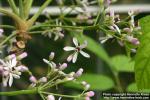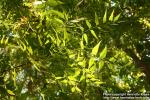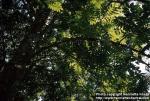 The bark of the root of Melia Azedarach, Linné.
The bark of the root of Melia Azedarach, Linné.
COMMON NAMES: Pride of India, Pride of China, Bead-tree, Indian lilac, African lilac, and Persian lilac, a name properly belonging to Syringa persica.
Botanical Source.—This elegant tree, attains the height of 30 or 40 feet, with a trunk about 11 feet in diameter, and divaricate branches. The bark is rough. The leaves are alternate and unequally bipinnate; the leaflets opposite, ovate, acute, serrated, sometimes incised, and in pairs with an odd one. Lilac-colored flowers are borne in terminal panicles, on axillary peduncles. The corolla consists of 5 petals, patent, pale-pink inside, deep-lilac outside; the calyx is 5-parted. Stamens with tube 10-cleft at top, deep-violet; anthers yellow. Ovary 5-celled; stigma 5-lobed; style columnar. The fruit is a drupe the size of a small olive, with one 5-celled, bony nut; the cells are 1-seeded (L.).
History.—This tree, although a native of several Asiatic countries, is cultivated in the warm climates of Europe and America; it does not grow to any extent north of Virginia, and flowers early during the spring. Its name of Beadtree was derived from the use to which its hard nuts are put in Roman Catholic countries, viz.: for making rosaries. The recent bark of the root is the most active part for medicinal purposes. It has a disagreeably bitter taste, and a very unpleasant odor, and imparts its properties to water at 100° C. (212° F.), and to weak alcohol. A fluid extract might possibly be prepared from it for general use. Quite a quantity of alcohol may be obtained from the berries by fermentation. This drug was early used by the Arabs and Persians. In the East the flowers and leaves are used locally to cure nervous headache, and a poultice of the flowers is employed to destroy lice and cure scalp eruptions. The fruit, though poisonous, is given in scrofula and leprosy (Dymock, Mat. Med. Western India).
Description.—The commercial bark comes in curved or irregular pieces, or quills, which break with a somewhat fibrous fracture. They vary considerably in length and thickness; are reddish-brown externally, with irregular ridges running lengthwise, of a blackish color. The inner surface also has longitudinal markings, and is either whitish or light-brown in color. It has a sweetish, succeeded by nauseous, bitter taste, and is without odor. The bark of old roots has a thick, corky layer, of a rust-color, which must. be removed if a good article is desired. It has scarcely any taste.
Chemical Composition.—Jacobs, in 1879, obtained the bitter resinous constituent of this bark, of a yellow-white color. It dissolves readily in alcohol, chloroform, and ether, and is but partially soluble in carbon bisulphide, turpentine, benzin, and water; scarcely at all in the last three. Its other constituents are thought to be similar to those of the Azadirachta indica (see below).
Action, Medical Uses, and Dosage.—The bark is anthelmintic, and in large doses narcotic and emetic. Kollock states that if gathered in the spring of the year, during the ascent of the sap, it will cause narcotic symptoms resembling those occasioned sometimes by Spigelia. Among the effects of over-doses are dizziness, dimness of vision, confusion of the mind, tendency to syncope, vomiting, stertorous respiration, coma, pupillary dilatation, cold perspiration, and catharsis. It is useful in worm fevers and in infantile remittents, in which, although worms are absent, yet the symptoms are similar to those accompanying the presence of worms. Dose of the powdered bark, 20 grains; of the decoction (which is the best form for administration, 2 ounces of the bark to 1 pint of water, and boiled to ½ pint), 1 tablespoonful every 1, 2, or 3 hours till the desired effect obtains; a purgative should follow its employment. The fruit is somewhat saccharine, and is said to bean active anthelmintic; its pulp has been used in an ointment for destroying lice and other ectozoa, as well as in the treatment of scald-head and other diseases of the skin. By expressing the nuts an oil may be obtained which is said to possess anthelmintic properties, and to be useful as a local application to rheumatic affections, cramps, obstinate ulcers, etc. As an anthelmintic it has attained considerable reputation in-our Southern States, where the bark may be obtained fresh.
 Related Species.—Melia Azadirachta, Linné (Azadirachta indica, Jussieu). Ním tree of India, where it is cultivated extensively for medicinal use. The bark is a bitter, astringent tonic. The leaves are used in glandular enlargements, pustular, cutaneous diseases, and their juice as an anthelmintic. The fermented sap of the tree is employed as a stomachic. It is regarded reverentially by the superstitious natives, who believe that syphilis is cured by waving a ním branch in the air, and that the insane are cured by passing through an opening formed by reunion of the extremities of the parts of a cleft limb, or trunk of the tree. Hove found a decoction of the leaves useful in liver disorders and intermittents. The drug is official in the Pharmacopoeia of India (see Dymock, Mat. Med. of Western India).
Related Species.—Melia Azadirachta, Linné (Azadirachta indica, Jussieu). Ním tree of India, where it is cultivated extensively for medicinal use. The bark is a bitter, astringent tonic. The leaves are used in glandular enlargements, pustular, cutaneous diseases, and their juice as an anthelmintic. The fermented sap of the tree is employed as a stomachic. It is regarded reverentially by the superstitious natives, who believe that syphilis is cured by waving a ním branch in the air, and that the insane are cured by passing through an opening formed by reunion of the extremities of the parts of a cleft limb, or trunk of the tree. Hove found a decoction of the leaves useful in liver disorders and intermittents. The drug is official in the Pharmacopoeia of India (see Dymock, Mat. Med. of Western India).
Margosa bark (Ním bark), as this drug is called, contains a substance considered as an alkaloid by Cornish (1856) and to which he gave the name margosine. It has a bitter taste, and was obtained only in exceedingly small amounts as a "double salt of margosine and soda," taking the form of long, white, acicular crystals (Pharmacographia). The composition of margosine and of margosic acid, obtained by the same experimenter from a bitter oil contained in the seeds, is unknown. Broughton (Pharm. Jour., 1873) believed the bitter principle to reside in an amorphous resin having the formula C36H50O11. He also obtained a crystalline principle of unknown character, which he, however, thought to be a fatty body, a view not participated in by Flückiger on account of its high melting point, 175° C. (347° F.) (Pharmacographia).
Melia dubia, Cav. India. The dried fruit is used by the poorer classes as a remedy for colic, the half of a fruit very effectually relieving the pain. The green fruit, with sulphur and curds, is employed in scabies (Dymock).
Soymida febrifuga, Jussieu (Swietenia febrifuga, Willdenow). Nat. Ord.: Meliaceae. This is the Rohuna or Rohun tree of Hindustan, and is known on the Coromandel coast of India as Redwood tree, and is the only known species of the genus. The bark is very bitter and astringent, and was recommended by Roxburgh as a substitute for cinchona. It was admitted into the Edinburgh Pharmacopoeia in 1803, and in 1807 into the Dublin Pharmacopoeia. It is used as a tonic and also as an antiperiodic; but, according to Ainslie, if given beyond the extent of 4 or 5 drachms in 24 hours will derange the nervous system and occasion vertigo and subsequent stupor. It is said to have been employed in India with success in the treatment of gangrene (?); and in Great Britain as an astringent, and in the treatment of typhus fever. Waring, who has employed it, considers it to be a bitter tonic and not a febrifuge.
Swietenia Mahogoni, Linné. Mahogany tree. West Indies, Mexico, and the American tropical region. Yields the well-known wood, mahogany. Bark bitter and astringent; contains catechin.
Khaya senegalensis, Guillemin et Perrottet. Bark and wood similar to preceding; contains an alkaloid (Caventou). Used in Africa in intermittents.
 Carapa guiaensis, Aublet, and Carapa Touloucouna, Guillemin et Perrottet. Bark anthelmintic; seeds yield crab, kundah, or callicoonah oil, which is non-volatile and bitter.
Carapa guiaensis, Aublet, and Carapa Touloucouna, Guillemin et Perrottet. Bark anthelmintic; seeds yield crab, kundah, or callicoonah oil, which is non-volatile and bitter.

